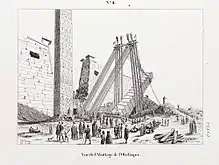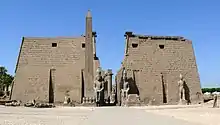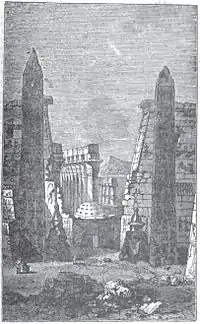Luxor Obelisks
The Luxor Obelisks (French: Obélisques de Louxor) are a pair of Ancient Egyptian obelisks, over 3,000 years old, carved to stand either side of the portal of the Luxor Temple in the reign of Ramesses II (c. 1250 BC). The right-hand (western) stone, 23 metres (75 ft) high, was moved in the 1830s to the Place de la Concorde in Paris, France, while the left-hand (eastern) obelisk remains in its location in Egypt.
The Luxor Obelisk in Paris was classified officially as a monument historique in 1936.
Together in Egypt
Creation
The Luxor Temple predated Ramesses II by about 150 years. During his reign, renovations were made that included the addition of the two obelisks.
The obelisks were each carved from a single piece of red granite, quarried about 100 miles (160 km) south of Luxor in Aswan, transported on a specially designed barge, and lowered into place with ropes and sand.[1]
Physical features
The two obelisks were slightly different heights, and the one remaining in Luxor is taller. The shorter obelisk was mounted on a taller pedestal and placed farther from the pylon than the other. To an advancing spectator the obelisks may have appeared to be the same height, and this design choice may have been highly deliberate.[2][3]
The obelisk remaining in Luxor is leaning.[4] The Paris obelisk has a fissure in the original stone that had been tended to in antiquity.[5]
The eastern and western faces of each obelisk were slightly convex, the only two ancient obelisks with the feature, and the reason for this is not understood.[2]
Hieroglyphics
Both obelisks are marked with hieroglyphics. In the 1800s François Chabas produced a full translation of the western (Paris) obelisk, which is about Ramesses II, Amun-Ra, and Horus, and can be read here.
Luxor Obelisk in Paris

Idea
The idea to transport the Luxor Obelisks to Paris appeared first during Napoleon's campaign in Egypt. On March 21, 1799, General Louis-Charles-Antoine Desaix wrote a letter to Napoleon informing him of the existence of two obelisks in Thebes which would constitute an extraordinary sight once brought to Paris.[6] Similarly, Vivant Denon recalls in his 1802 Voyage dans la basse et la Haute Égypte the possibility to bring the obelisks to Paris as a trophy of French conquest.[7] Finally, on October 8, 1800 Jean-Marie-Joseph Coutelle presented before the Institut d'Égypte in Cairo the first technical considerations on the transport and erection of one of the obelisks to the Place de la Concorde.[8] With the eventual end of the French Campaign in Egypt, these plans, however, were never realized.
Under Napoleon's successor, Louis XVIII, the French acquired rights to Cleopatra's Needle in Alexandria, though this obelisk was never moved to France and ended up in New York City in 1881.
In the 1820s King Charles X opened an Egyptian Museum and sought an obelisk as a piece of Egyptian art. Around this time, Jean-François Champollion, who had recently achieved prominence for his decipherment of the Rosetta hieroglyphs, saw the Luxor obelisks for the first time and urged the French government to acquire them over any other obelisks.[9]
Gift

In November 1830, Muhammad Ali Pasha, ruler of Ottoman Egypt, officially gave the Luxor obelisks to France. This was in spite of the fact that the obelisks had previously been given to the British and the fact that the French diplomat arranging the acquisition, Baron Taylor, had been authorized to do so by Charles X, who had been overthrown in July.[10]
In reciprocation for the gift, France gave the Ottomans a mechanical clock in the 1840s, today known as the Cairo Citadel Clock.[4] The clock has rarely worked since its arrival in Cairo, but in 2021 the Supreme Council of Antiquities announced that "Egypt is seeking to repair the citadel clock, one of the oldest of its type in the world, so that it will work again."[11][12]
In 1981, President François Mitterrand of France definitively renounced possession of the second obelisk, thus restoring its property to Egypt.
Transport and re-erection

It was decided that the western (shorter) obelisk would be moved first, and in 1831, it was taken down. It was transported by a ship custom-built for the transport, the Luxor. It arrived in Paris in 1833 and was erected in 1836 at the centre of Place de la Concorde by King Louis-Phillipe.
The total cost of relocating the obelisk was estimated at 2.5 million francs (equivalent to an estimated €16 million or $19 million in 2020).[13][14] The high cost may be why the second obelisk was never moved.
Pedestal
.jpg.webp)
The present-day pedestal was originally intended for an equestrian statue by Jean-Pierre Cortot of Louis XVI, but the statue was destroyed during the July Revolution in 1830. In 1839, diagrams explaining the complex machinery that was used for the transportation were added to the pedestal.[15]
The original Egyptian pedestals involved sculptures of baboons with prominent male genitalia, raising their hands to the sun. A fragment of this original pedestal from the rear of the remaining obelisk was brought to Paris at the same time as the obelisk, intended to be displayed with it. Deemed too obscene for public exhibition, it was sent to the Egyptian section of the Louvre.[16]
Pyramidion
France added a gold-leafed pyramid cap to the top of the obelisk in 1998.[17] It had long been suspected that the bare pyramidion had originally been covered with a bronze, gold, or electrum cap,[18] perhaps even stolen in the 500s BC.
With the pedestal and cap, the height of the monument is 109 feet.[19]
Modern events
- On 1 December 1993, demonstrators from Act Up Paris, an organization dedicated to fighting AIDS, covered the Parisian obelisk with a giant pink condom to mark World AIDS Day.[20][21]
- In 1998 Alain "Spiderman" Robert, the French urban climber, illegally scaled the Parisian obelisk without the use of any ropes or other climbing equipment or safety devices.[22]
- In 1999 as part of Paris's millennium celebration activities, 300 brass disks and nearly 1,000 feet of yellow thermosensitive strips were placed around the obelisk in order to use the it as the gnomon of a functioning sundial. They remained until the end of the year 2000.[19]
- In 2015 Milène Guermont's monumental interactive sculpture PHARES[23] was displayed next to the obelisk for several months, where it was designed to illuminate the obelisk.
References
| Wikimedia Commons has media related to Luxor Obelisk. |
- "Building the Great Obelisks at Luxor", History, retrieved 8 October 2021
- Gorringe, Henry Honeychurch (1882). Egyptian Obelisks. author. p. 119.
- Illusionism in Egyptian Architecture (PDF). 1969. p. 23.
- "Egypt's Obelisks Are No Longer Standing Tall". Los Angeles Times. 22 July 1990. Retrieved 8 October 2021.
{{cite web}}: CS1 maint: url-status (link) - Gorringe, Henry Honeychurch (1882). Egyptian Obelisks. p. 86.
- Sauzet, Armand. Desaix, le sultan juste. p. 234.
- Denon, Vivant (1989). Voyage dans la basse et la haute Égypte. Le Caire: Institut français d'archéologie orientale. p. 21.
- Bret, Patrice (2001). "Le Guerrier Philosophie Desaix, L'institut d'Égypte et la commission des sciences et arts". Annales historiques de la Révolution française. 324: 72.
- Gorringe, Henry Honeychurch (1882). Egyptian Obelisks. p. 77.
- Gorringe, Henry Honeychurch (1882). Egyptian Obelisks. p. 78.
- Nevine El-Aref. "175-year-old Cairo Citadel clock to be repaired". ahramonline, 6 May 2021.
- "Egypt's first ticking clock ticks again - Al-Monitor: The Pulse of the Middle East". www.al-monitor.com. Retrieved 9 October 2021.
- L'Abeille (in French). Petit Séminaire de Québec. 1848.
- "Historical Currency Converter". www.historicalstatistics.org. Retrieved 5 October 2021.
- Solé, Robert (2004). Le Grand Voyage de l'Obélisque. p. 199. ISBN 9782020392792.
- "Four baboons adoring the rising sun | Louvre Museum | Paris". 8 July 2015. Archived from the original on 8 July 2015. Retrieved 9 October 2021.
- "Paris obelisk finally gets its gold cap". The Independent. 23 October 2011. Retrieved 9 October 2021.
- Gorringe, Henry Honeychurch (1882). Egyptian Obelisks. p. 82.
- Burke, Rose Marie (10 September 1999). "Millennial Countdown Is Aided by a Sundial". Wall Street Journal. ISSN 0099-9660. Retrieved 8 October 2021.
- "Civismemoria.fr - Interviews en tout genre !". Archived from the original on 8 March 2009.
- http://www.qrd.org/qrd/aids/cdc/daily.summaries/1993/12.01.93
- "FRANCE: PARIS: 'SPIDERMAN' ALAIN ROBERT STRIKES AGAIN | AP Archive". www.aparchive.com. Retrieved 2 October 2021.
- "Phares (2015)".
- Bret, Patrice (2001). "Le Guerrier Philosophie Desaix, L'institut d'Égypte et la commission des sciences et arts". Annales historiques de la Révolution française. 324: 69–82. doi:10.3406/ahrf.2001.2517.
- Follert, Michael. (2014). Enjoyment Petrification: The Luxor obelisk in a melancholic century.
- Levin, William C. (2006). Cultural Commentary: Le Vin in Paris. Bridgewater Review, 25(1), 30-32. Available at:
- Place de la Concorde: Obélisque de Luxor


